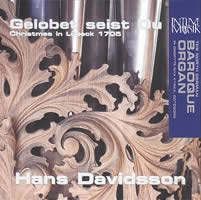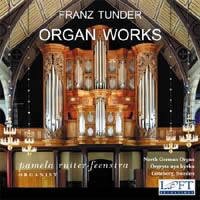Göteborgs Wond’rous Machine
|
W.A. Grieve-Smith [March 2003.]
GELOBET SEIST DU: Christmas in Lübeck 1705. Dietrich BUXTEHUDE: Praeludium in C (BuxWV 137). Gelobet seist Du, Jesu Christ (BuxWV 189). Matthias WECKMANN: Gelobet seystu Jesu Christ. Est ist das Heil uns kommen her. Nicolaus BRUHNS: Praeludium in E. Arvo PÄRT: Pari Intervalo. J.S. BACH: Toccata, Adagio and Fugue in C (BWV 564). Hans Davidsson, organ. INTIM MUSIK IMCD 078 (79:23). When we think of pipe organs, we usually envision the big tin whistles up front, the prestants or display pipes. Fact is, apart from many metal pipes, organs are mostly made of wood: wind chests, wind trunks, bellows, keyboards and the tracker rods connecting the keys with the wind chests. So it has been natural for organ builders, when enlarging or replacing worn wooden parts, to recycle perfectly good and sometimes quite valuable metal pipes. Even the famous Arp Schnitger, whose name actually means ‘joiner,’ in 1686 at the Ludgerikirche in Norden recycled pipes from earlier de Mare and Evers instruments. In Hamburg at the Jacobikirche in 1689, Schnitger incorporated pipes made by the Scherer and Fritsche families into the famous 1693 organ which Jürgen Ahrend beautifully restored in 1993. (The wood had become worm-infested and had to be replaced.) At Saint-Sulpice in Paris, Atristide Cavaillé-Coll added a swell box and romantic stops, plus a pneumatic (Barker lever) console to a magnificent 1781 Henri Clicquot organ to create the 19th Century Romantic organ, for many years the largest instrument in Europe. Besides restorations and enlargements, organ makers worked at reproductions. At Freiburg University before World War II, an instrument was built following Michael Praetorius’ measurements and specifications in his Syntagma Musica of 1619. Many European firms like Flentrop, von Beckerath, Marcussen, Frobenius, Kern, Metzler, Rieger and Ahrend also built repros of classic Renaissance and Baroque designs. In the U.S., Donald Harrison built a Praetorius practice organ (with recycled electric console) in the basement of the Westminster Choir College in Princeton. Thanks to Dr. Alexander McCurdy, I got a personal tour of the instrument in 1948. And at the behest of E. Power Biggs (what a name for an organist!), Harrison cobbled together a Baroque instrument for the Germanic Museum at Harvard. Later Biggs had the Flentrop Orgelbouw build a proper 17th Century instrument which still sits in what is now called the Busch-Reisinger Museum. Returning to Sweden at Göteborgs Örgryta New Church, Prof. Hans Davidsson organized an entire team of scholars, engineers, craftsmen and donors to research and build a 4-manual organ modeled on the 1799 instrument Arp Schnitger built for the Cathedral in Lübeck. (Its keydesk still exists in a museum and was borrowed for measurements.) Jürgen Ahrend donated his measurements from his Jacobikirche restoration. They even reverse-engineered a way to cast lead pipes in sand. It was known to have been done, but no documentation exists as to exactly how they did it! In addition to being pumped by foot power, the organ is entirely meantone-tuned, with split black keys (accidentals). Fact is, g-sharp and a-flat are not the same note in quarter-comma meantone tuning. Using his proprietary ULSI technique, Erik Sikkema has recorded Prof. Davidsson in a truly spectacular demo CD of just what the organ can do. This is not SACD or DVD-A, folks — just some refinement of garden-variety CD. And it’s such an improvement it caused me to delay this review. I had to re-position my front speakers and re-jigger the resistance in my passive preamp/volume control. You listen and listen. And then you listen again. Was it worth it? And how! Sikkema has produced a recording with more ‘there’ there, to paraphrase Gertrude Stein. The big tin principals are deep and resonant and combine beautifully with the shimmering delicate mixtures and mutations to create an organ sound to die for. The sound is quite similar to the restored Jacobikirche instrument in Hamburg, but in an even more spacious, resonant environment. And the meantone tuning adds snazzy dissonances you just don’t get with equal-temperament tuning. In the Weckmann and Buxtehude chorale fantasias Davidsson uses colorful single stops in the polychoral style recommended by Harald Vogel. Here’s hoping Vogel will recover completely from a serious auto accident to record his complete edition of Samuel Scheidt’s Tabulatura Nova on this magnificent machine. I’m also requesting that Dr.Davidsson and Sikkema re-visit the complete Weckmann organ works they recorded at the Ludgerikirche in Norden, still available on MOTETTE DCD 11461. If you want to enjoy as never before the unique sound of 17th century Hanseatic organ music or simply want to rattle your subwoofers and break your lease, look no further than this groundbreaking demo. Purchasing note: go to http://www.intim-musik.se/ Or order from GOArt at http://www.goart.gu.se/
Franz TUNDER: Præludium in G. Jesus Christus wahr’ Gottes Sohn. Herr Gott, dich loben wir. Christ lag in Todesbanden. Præludium in F. Was kann uns kommen an für Not. Jesus Christus unser Heiland. Præludium in G. Auf meinen lieben Gott. Komm, Heiliger Geist, Herre Gott. Canzona. Præludium in G. In dich hab ich gehoffet, Herr. Præludium in G. Wass kann uns kommen an für Not. Pamela Ruiter-Feenstra, organ. LOFT 1048/49, 2 CDs (174:10). On the new Örgryte Hanseatic organ at Göteborg, Ruiter-Feenstra plays the extant organ works of Franz Tunder, Buxtehude’s father-in-law and predecessor at the Marienkirche in Lübeck. Here we enter an earlier era where the organist was considered a Minister of Melody in the Lutheran service, as the Cantor was the Minister of Song and the Pastor, the Minister of the Word. With the structured præludia the organist set the serious tone for the following worship service. During the service fantasias were improvised with the chorale melody played in whole notes (to give pause for reflection on the words). Chorale-fantasias were musical meditations, melodic rosary beads. The spoken word, the sung word and the played melody all induced the proper affekt (or mood) of reverence. Or indoctrination, depending on how you look at it. A pupil of Harald Vogel, Ruiter-Feenstra plays the præludia majestically im vollen Werk, even though she admits the oaken rollers make it heavy going. For the chorale-fantasias, she carefully chooses a cornucopia of individual stops and families in the polychoral style. And best of all, she gets the rhetoric exactly right! She inserts just the right amount of luftpausen between a figure and its echo on another manual. If you like to get lost in the relentless counterpoint of The Art of Fugue you will revel in Tunder’s spinning gothic webs of melody, all played without the slightest sense of hurry. After all, the worship of God was considered the best possible use of one’s time. The pungent sounds of meantone tuning, the glorious pipework sounding in an expansive but resonant environment, and the perfectly paced performance have been beautifully captured by Roger Sherman’s first-rate recording. Let’s hope these CDs are only the beginning of a thorough exploration of the repertory of the early 17th Century. Ordering: http://www.amazon.com/ has had this release available. Or check out http://www.loft.cc/. Also available at ArkivMusic.
[More W.A. Grieve-Smith]
[Previous Article:
Up from the Archives]
[Next Article:
An Intercepted Letter from Beth Levin]
|

